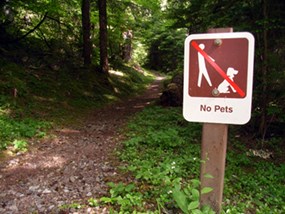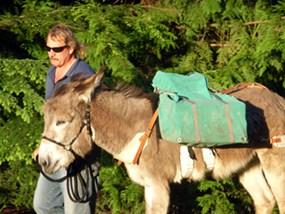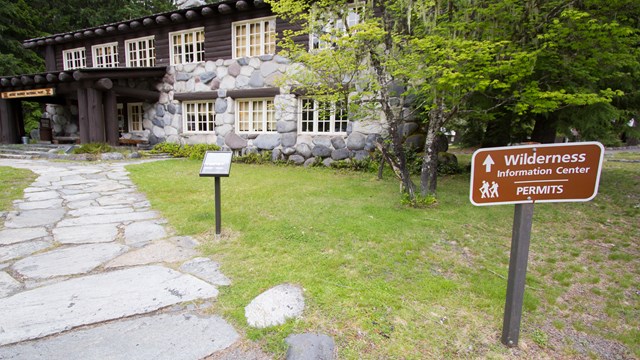
NPS Photo Carry the 10 EssentialsPack the "10 Essentials" and be prepared for minor injuries, sudden weather changes or delays. Always carry and know how to use:
For your care and safety:
For the care of the wilderness:The following items or activities are prohibited on the trails and in the backcountry of Mount Rainier National Park:
Also:
Any activity which damages or disturbs the resources of Mount Rainier is prohibited. The following recommendations, which include Leave No Trace principles, will assist you in your efforts to minimize resource damage. You will be rewarded with a memorable wilderness experience, and you will be helping to preserve that opportunity for others in the years to come. Wilderness CampingWilderness camping permits are required year-round for camping overnight in any area of the park’s backcountry. Climbing permits are required year-round for any day or overnight travel on glaciers or above 10,000 feet in elevation, including Little Tahoma. The climbing permit also serves as the wilderness camping permit for overnight trips. A climbing permit requires the purchase of an annual climbing pass for each member of the party. Seasons Defined:
Party Size:
Trailside Camping:Most backpackers prefer to use the established designated trailside camps along the park’s trail system. Camping along trails is only permitted at these established camps. All camps have primitive toilet facilities, marked sites, food storage poles (bear poles) for hanging food and garbage, and a nearby water source. A trailside camp has from one to eight improved sites, each of which will accommodate a party of 1-5 people. Individual sites will hold 3 small 2-person backpacking tents. Many of the trailside camps also have a group site for "group" parties of 6-12 people. These sites will typically hold 3-5 tents. Crosscountry Zone Camping:Crosscountry travel and camping is demanding, challenging, and rewarding. These beautiful, pristine areas can be rough and difficult to navigate (especially in poor weather). There are no maintained trails, campsites, or amenities, and water sources can be scarce in late season. Choosing to camp in a crosscountry zone requires a higher level of physical conditioning, knowledge and experience with Leave No Trace camping practices, and sound navigational skills. Crosscountry zone camping also offers an unparalleled opportunity for solitude and can be among the most rewarding experiences hiking has to offer. All crosscountry camping sites must be at least 1/4 mile away from any road or established trail. However, suitable terrain for camping is almost always much farther and may take an additional several hours to locate. Camps must also be at least 100 feet from lakes, streams, and other wetlands. Party size may not exceed 5 people in summer. Choose crosscountry camping only if you are adept with map and compass and are in excellent physical condition for enduring the additional challenge of crosscountry travel. Hikers doing the complete Wonderland Trail are limited to camping in designated camps only—the use of cross-country zones is not permitted. Alpine Zone Camping:Mountain climbers generally choose to camp on-route on the snow and ice covered areas on the slopes of Mount Rainier itself. Within the alpine zones, there are two high camps on the two most popular climbing routes (Camp Muir and Camp Shurman). Wilderness Camping and Climbing Policies
Follow the directions on the Wilderness Permit page to request a reservation. Leave No TraceWhen traveling in the wilderness of Mount Rainier National Park and the rest of the Pacific Northwest you should be prepared to Leave No Trace, or only minimal signs of your visit. The National Park Service is a cooperating agency in the Leave No Trace national educational program. Please incorporate the following ideas and practices into your planning and travel in the Northwest's wilderness area. Plan ahead and PrepareObtain a permit if wilderness camping. Know park regulations. Seek information regarding weather, route conditions, restrictions, less traveled routes, etc. Repackage food. Get rid of unnecessary containers, boxes, and bottles and utilize reusable containers or plastic bags. This saves weight and reduces litter for carry-out. Select appropriate equipment that will help you leave no trace. For example, gaiters that protect your feet and boots will allow you to stay on the trail when it's wet or muddy. Lightweight camp stoves, free-standing tents and collapsible water containers allow the flexibility to camp in the most impact-resistant site available. Be unobtrusive, select earth-toned clothing, tents and other materials. Know the area and what to expect. Camp and Travel on Durable SurfacesIn popular or high use areas, concentrate use. Hike on existing trails and select durable rest spots. In designated wilderness camps, camp only in designated sites. Dispose of Waste Properly“Pack it in, pack it out.” Reduce litter at the source by repackaging food into reusable containers. Reduce food waste leftover from cooking by planning meals carefully. Pack out all trash, food scraps and toilet paper. Be careful with small pieces of trash such as candy wrappers and twist ties that often fall out of pockets and litter trails. Please pick up after less thoughtful people who have gone before you. Human wasteThere are four guiding principles behind the Leave No Trace sanitation practices:
All trailside camps at Mount Rainier have pit or composting toilets. In a cross-county zones the "cathole" method is the most widely accepted alternative in areas with soil. To promote decomposition, choose a site in organic soil rather than sandy mineral soil. With a small garden trowel dig a cathole six to eight inches deep and four to six inches in diameter. Mix in dirt and cover, attempting to disguise the hole with brush and ground cover. Pack out all toilet paper. A less impacting option is to utilize “Blue Bags” and pack out all your waste, depositing the bags in designated collection barrels. In alpine zones, climbers are required to utilize the Blue Bag system. Leave What You FindMinimize site alterations. Leave all sites as you found them. Do not dig trenches, level sites, or construct tables, chairs, or rock cairns. Clean up a site with these intrusions. Avoid damaging live trees and plants. Never hammer nails into trees or girdle trunks with tent lines. Pick only berries and only pick what you can consume on the spot. Leave natural objects and cultural artifacts. Natural objects of beauty or interest such as rocks, antlers or fossils, must be left undisturbed for others to enjoy. It is illegal to disturb or remove any such objects in a National Park. The same applies to cultural artifacts such as pot shards, projectile points, and other items. Respect WildlifeDo not feed or approach any animal. Hang your food. In some sub-alpine areas without tall trees, the use of a bear-proof canister is highly recommended. Remember to place other scented products, like toothpaste, deodorant and trash, along with your food. Be Considerate of Other VisitorsBe considerate of other visitors and help protect the quality of their experience and desire for solitude. Let nature’s sounds prevail; avoid loud voices and noises. In crosscountry zones, camp out of sight of trails and minimize the visual impact of your presence. Find a balance between ecological and social impacts. 
Stock UseSaddle and pack animals (horses, mules, burros and llamas) are welcome on the Pacific Crest Trail and on the Laughingwater Creek Trail from State Route 123 to the Pacific Crest Trail near Carlton Pass. Trails are often snow covered until mid-summer. Rough terrain, difficult river crossings, and drastic elevation changes have challenged many people with stock. Check trail conditions before you arrive. Three Lakes Camp Three Lakes Camp is open to stock use. Please keep stock animals at least 100 yards from other campsites. Tie stock only at hitching rails. To camp at Three Lakes, you will need a wilderness permit, available at wilderness information centers and most ranger stations. Party Size You may bring a maximum combination of 12 people and stock animals on the Pacific Crest Trail and a maximum of 5 head of stock on the Laughingwater Creek Trail. Grazing In order to protect fragile native vegetation, stock animals must not graze in the park. Carry an adequate supply of pellet feed. To prevent the spread of alien plants and weeds, feed animals pellet feed for at least two days prior to entry into the park. Never dump or leave animal droppings in parking areas or along roadways. Parking Stock trailer parking is available across the road from the trailhead at Laughingwater Creek. Two parking lots suitable for stock trailers are also available at Chinook Pass for acess to the Pacific Crest Trail. These parking lots are just outside the National Park boundary. Thank you for being a responsible backcountry visitor, and helping protect Mount Rainier National Park. 
Wilderness Permits
A wilderness permit is required for all overnight camping. Learn how to reserve a permit or acquire a first-come, first-served permit. 
Hiking Safety
No matter the length of your hike, being aware of risks can help make your hiking experience safe and enjoyable! 
Meadow Preservation
Preserve and protect Mount Rainier's precious subalpine meadows by staying on trail during your visit. |
Last updated: December 13, 2024
